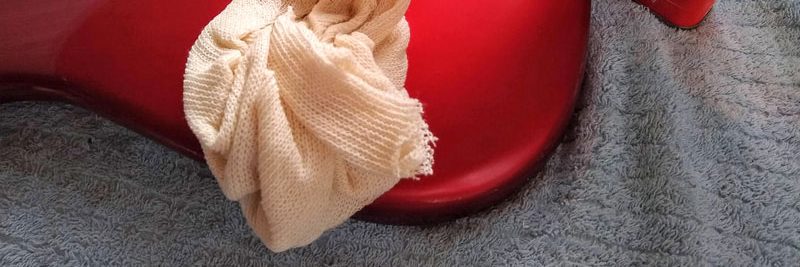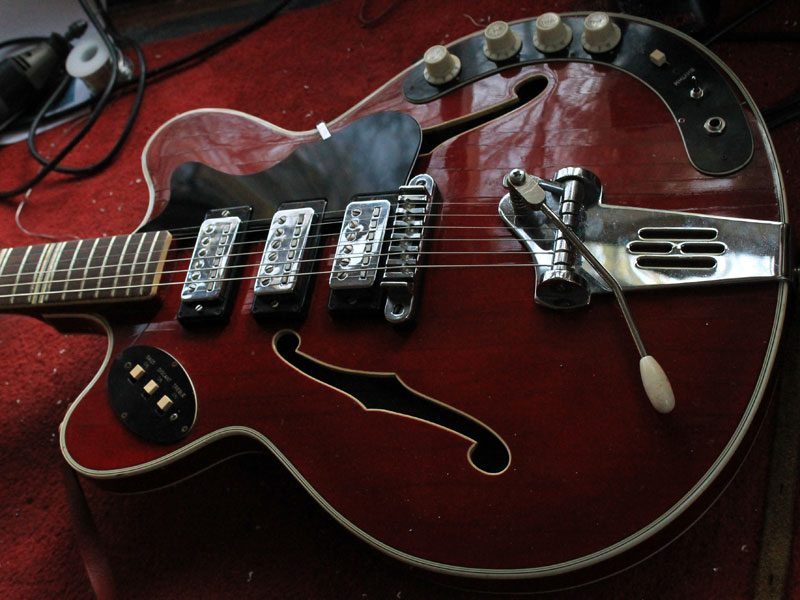
Höfner Model 4575 65-3

This Höfner Model 4575 “65-3” guitar which dates to 1965/66 and I’ve just rewired it as the controls were unreliable. despite a good clean.
Alan at Project Guitar Parts supplied the switches and also a reproduction pickguard and bracket. The pickguard needed to be cut to accommodate the pickups.
Eagle-eyed aficionados will spot that the tremolo arm is not correct and the owner’s next job is to source one to fit.

i have an opportunity to buy one of these in original good condition…any idea what one of these is worth??
No idea sorry, try looking on Reverb or eBay for sold items
I had one of these (as it had the label it would’ve been a 65-3). That’s one volume, three tone controls there, you could get an incredible range of tones using various combinations of pickups and tone control settings, and I turned a switch on the main control plate into a phase switch for the middle pickup, which increased it again. Before I bought it the previous owner had had the neck slimmed down, so that was a natural finish, and it was a lovely guitar to play.
When I split up with my girlfriend and moved out she said she’d miss that guitar as she loved the look of it, especially the striped look of the wood on the back, so I said I’d leave it with her so I’d have something to ‘twing’ when I visited, as we were still on friendly terms. And that’s what happened. After a year or so she met a new guy, who I Iiked, and he eventually moved in. My visits grew fewer as I didn’t want to get in the way, but after a few years she was diagnosed with terminal cancer, and a year after that, she died. As he’d just lost someone he loved I didn’t have the heart to ask him if I could have my guitar back, and so I lost it. He’s moved on now, I don’t know where he or the guitar is, or if he even still has it, but I miss it so much. It was a beauty, and a link to her.
Ive been speaking to a guy I know who has a black telecaster that was owned and signed by John Lennon. He lent it to someone in the early 80s and never saw it again. Your story reminded me of his…although your strory is full of goodness and good karma for you…
Hi Mike, thank you for your kind comment. I just thought I’d give you an update – as of about two weeks ago, with the aid of a bit of luck in spotting the ad on Ebay in time and some money from a redundancy payment I have another 4575 (I found a new job within two weeks, too) .
It’s red, the same as my lost one, but in better condition – most of the finish looks like it’s almost new, which is amazing for a 56 year old guitar, and though it doesn’t have that slimmed down neck it is a joy to play. It has the Hofner tremelo as per the one in your photo as opposed to the Bigsby of my old one, and I have to say compared to the macho clunkiness of the Bigsby it’s a lovely bit of design, and works well.
For those that don’t know, there’s a white slider switch (visible in the pic) marked ‘Solo’ and ‘Rhythm.’ Next to it, where the little metal toggle switch is in the one in your pic, is another pot which enables you to set the rhythm volume. That’s what would’ve been there originally in the one you repaired.
Although it’s not my lost guitar, it sort of nearly is (though it cost me a lot more as I bought my original in the early eighties before guitars became investment objects), and I’m so happy to have one again, having missed mine for 18 years. I can’t stop playing it.
Yours, Keith.
Is there a label inside the body cavity?
Geoff
http://www.verithingeoff.com
I can’t remember Geoff, it was seven and a half years ago!
Thanks for the reply Steve
The reason for my question is that the 4575 and 65-3 are different guitars. The 4575 was built for distribution worldwide, excluding the UK, and had no serial number. The 65-3 was built specifically for the Selmer Company for sale in the UK and had a label with the model and serial number
How much for this Guitar Höfner Model 4575 65-3
Best regards Thomas Blangs
@Davide – I have a 4575 Cherry Red for sale you are still looking ?
Mr 4575
How much
A Hofner just like this one fell in my hands in early 1979, from my music teacher Robert Barta who lived in Downey, CA. I played it throughout ’79, and it went into deep storage for a long time. When it emerged from the caverns in 1994, the electronics were shot, and I didn’t have the means to repair them, so I traded the guitar for some recording gear at a music store in Sherman Oaks.
I would be very interested to learn what became of that guitar after it left my hands.
Are u selling it?
It isn’t mine to sell!
Are you still looking for a Hofner 4575?